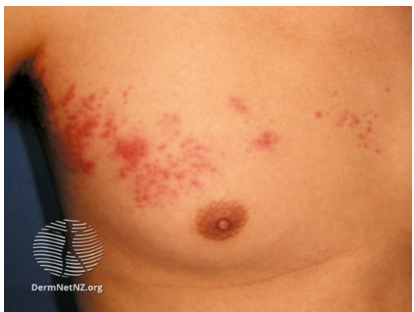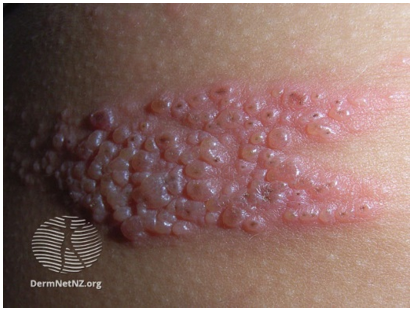Comments from Expert Advisory Group
Reactivation of dormant varicella zoster virus results in herpes zoster (shingles)
|
Herpes Zoster on the chest
Image source: https://dermnetnz.org/
|
 |
|
Close-up of Herpes Zoster blisters
Image source: https://dermnetnz.org/
|
 |
Prescribing Considerations
- Prescribe an oral antiviral within 72 hours of onset of rash in all patients over 50 years of age (to reduce risk of post-herpetic neuralgia)
- Prescribe an oral antiviral within 72 hours of onset of rash for patients with one or more of the following:
- Ophthalmic Herpes Zoster
- Ramsey Hunt syndrome
- Severe Atopic Dermatitis/Eczema
- Rash affecting arms, legs, neck or genital areas
- Moderate or severe pain
- Moderate or severe rash
- Immunocompromised patients: consider referral to secondary care. If treating with antivirals, use extended durations as recommended in the dosing table
- Consider prescribing an antiviral up to one week after onset of rash in the following:
- High risk of severe shingles or continued vesicle formation
- Older age
- Immunocompromised
- Severe pain
- Multidermatomal
- Seek secondary care advice in patients who are:
- Pregnant/Breastfeeding
- Immunocompromised
- Forming new vesicles after 7 days of antiviral treatment
- Experiencing recurrent shingles
- Experiencing Opthalmic Herpes Zoster with Hutchinson’s sign, visual symptoms or an unexplained red eye
Consider shingles vaccination at convalescence.
Treatment
| Shingles Antiviral Treatment (Adults) |
| Drug |
Dose |
Duration |
Notes |
| 1st line option |
|
Valaciclovir
|
1g every 8 hours
|
7 Days
And if immunocompromised:
continue for 2 days after crusting of lesions.
|
Dose reduction in renal impairment
|
| 2nd line option |
|
Aciclovir
|
800mg Five Times Daily
Doses to be taken five times a day at approximately 4 hourly intervals, during waking hours. |
7 Days
And if immunocompromised:
continue for 2 days after crusting of lesions.
|
Dispersible Tablets and Liquid Available
Dose reduction in renal impairment
|
| 3rd line option |
|
Famciclovir
|
500mg every 8 hours
|
7 Days
And If immunocompromised:
10 days and continue for 2 days after crusting of lesions.
|
Dose reduction in renal impairment
|
General Advice for Self-Care with Shingles
- Patients should:
- Be advised they are contagious until all the vesicles have scabbed over (usually 5-7 days after rash onset)
- Wear loose-fitting clothing to reduce irritation
- Take simple OTC analgesia
- Keep the rash clean and dry to reduce risk of bacterial infection
- Avoid topical creams and adhesive dressings
- Seek medical advice if pyrexia develops
- Patients should be advised to try avoid coming into contact with:
- Pregnant women who never had chickenpox before
- Immunocompromised patients
- Babies less than 1 month old – unless it’s your own baby
Patient Information
- Doses are oral and for adults unless otherwise stated
- Renal impairment dosing table
- Safety in Pregnancy and Lactation
- Drug interactions table. Extensive drug interactions for clarithromycin, fluoroquinolones, azole antifungals and rifampicin. Many antibiotics increase the risk of bleeding with anticoagulants.
- Visit the Health Products Regulatory Authority (HPRA) website for detailed drug information (summary of product characteristics and patient information leaflets). Dosing details, contraindications and drug interactions can also be found in the Irish Medicines Formulary (IMF) or other reference sources such as British National Formulary (BNF) / BNF for children (BNFC).
Reviewed November 2022
